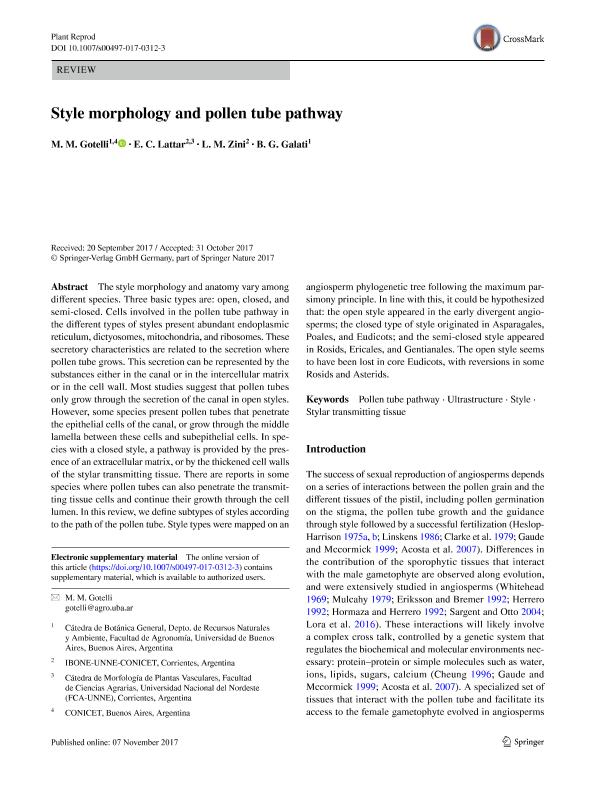Artículo
Style morphology and pollen tube pathway
Fecha de publicación:
11/2017
Editorial:
Springer Berlin Heidelberg
Revista:
Plant Reproduction
ISSN:
0934-0882
e-ISSN:
2194-7961
Idioma:
Inglés
Tipo de recurso:
Artículo publicado
Clasificación temática:
Resumen
The style morphology and anatomy vary among different species. Three basic types are: open, closed, and semi-closed. Cells involved in the pollen tube pathway in the different types of styles present abundant endoplasmic reticulum, dictyosomes, mitochondria, and ribosomes. These secretory characteristics are related to the secretion where pollen tube grows. This secretion can be represented by the substances either in the canal or in the intercellular matrix or in the cell wall. Most studies suggest that pollen tubes only grow through the secretion of the canal in open styles. However, some species present pollen tubes that penetrate the epithelial cells of the canal, or grow through the middle lamella between these cells and subepithelial cells. In species with a closed style, a pathway is provided by the presence of an extracellular matrix, or by the thickened cell walls of the stylar transmitting tissue. There are reports in some species where pollen tubes can also penetrate the transmitting tissue cells and continue their growth through the cell lumen. In this review, we define subtypes of styles according to the path of the pollen tube. Style types were mapped on an angiosperm phylogenetic tree following the maximum parsimony principle. In line with this, it could be hypothesized that: the open style appeared in the early divergent angiosperms; the closed type of style originated in Asparagales, Poales, and Eudicots; and the semi-closed style appeared in Rosids, Ericales, and Gentianales. The open style seems to have been lost in core Eudicots, with reversions in some Rosids and Asterids.
Palabras clave:
Pollen Tube Pathway
,
Ultrastructure
,
Style
,
Stylar Transmitting Tissue
Archivos asociados
Licencia
Identificadores
Colecciones
Articulos(IBONE)
Articulos de INST.DE BOTANICA DEL NORDESTE (I)
Articulos de INST.DE BOTANICA DEL NORDESTE (I)
Citación
Gotelli, Marina María; Lattar, Elsa Clorinda; Zini, Lucia Melisa; Galati, Beatriz Gloria; Style morphology and pollen tube pathway; Springer Berlin Heidelberg; Plant Reproduction; 30; 4; 11-2017; 155-170
Compartir
Altmétricas




